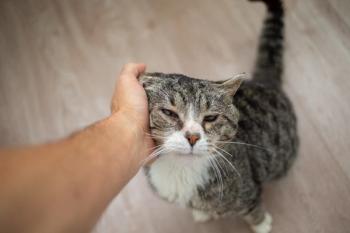
- dvm360 December 2020
- Volume 51
- Issue 12
Failing to meet their minimum environmental needs is killing cats
If you ask a random cat owner what they are doing for environmental enrichment for their cat, their likely response would be “What is environmental enrichment?” And that is precisely the problem.
Our clients have no idea what environmental enrichment means. Most of them are not providing it, and that is killing our patients. Yes, killing. The No. 1 cause of death for cats is something we are not treating or educating clients about: euthanasia. And the most common reason for euthanasia in cats is behavior problems. We know why the behaviors happen, we know what cats need to minimize or eliminate these behaviors, and yet we avoid even bringing it up with clients.
Imagine not treating or educating your clients about cancer or kidney disease. Unthinkable, right? And yet your feline patients are less likely to lose their life to either of these. So, why are we ignoring environmental enrichment?
The repercussions of not meeting cats’ needs
The evidence is clear that failing to meet cats’ needs in the indoor environment results in more than just euthanasia—it makes them sick by contributing to obesity, lower urinary tract disease, gastrointestinal disease, dermatologic disease, endocrine disease, and more.
Is providing for a cat’s needs really enrichment? If lacking these resources is killing cats and contributing to most of the diseases they face, shouldn’t we redefine minimum cat care requirements, educate our clients about what those requirements are, and give them the tools to fulfill those requirements successfully?
In our profession, we suffer from compassion fatigue. I get it. I really do. Our clients break our hearts and wear us out. They come in full of enthusiasm for kitten vaccines and then we don’t see them again until they are at the end of their rope because their cat is chronically urinating outside the litter box. Then, they might implore us to perform a convenience euthanasia. When their cat has destroyed their furniture and they just can’t deal with it anymore, they ask us to perform a declaw. When their cats keep fighting with each other, we drain their abscesses, sew them up, and talk about re-homing. Some days it is just too much to bear.
This is a vicious cycle
Cats’ needs are not intuitive to humans, and most clients do not know where to turn for behavior and cat care counseling when things start to go wrong. They guess, ask a friend, turn to Google, or just ignore the problem. When the behavior becomes intolerable, they take the cat to the shelter or simply put it outside.
At that point we have lost a patient and a client. We have lost the opportunity to listen to this cat’s heart, palpate its abdomen, perform a dental, and engage with an informed and grateful client.
Cats are counting on us
But, my colleagues, we can get in front of this problem. We can save lives. After all, isn’t this why we became veterinarians? Our clients are looking to us for education and support at their first kitten visit. They are looking for more than vaccines and screening blood work at their annual visits. The time to inform and educate our clients about minimum cat care needs is before the human-animal bond—and our professional spirits—break.
The science is there. The American Association of Feline Practitioners (AAFP) has beautifully laid out the 5 pillars of feline environmental enrichment, why they are important, and the consequences of denying our cats the resources they need to be physically and emotionally healthy in the indoor environment.1
In case you have not had the opportunity to read this entire position statement, here’s my favorite bit: “Many behavioral and physical disorders that are seen in cats are often secondary to stress from lack of appropriate stimulation. Environmental enhancement should be part of the overall treatment plan for these disorders. As part of the wellness exam, it is the responsibility of the veterinarian to discuss the current state of the environment and to provide resources for environmental enhancement to indoor cat owners.
It is well known that if an appropriate environment is not provided for indoor cats, they are at greater risk for stress-induced illnesses such as the following:
- Feline lower urinary tract disease
- Obesity
- Different forms of aggression
- Overgrooming and other compulsive disorders
- Upper respiratory infection
In an attempt to prevent the above conditions, it should become routine for the veterinary team to inform owners of the importance of environmental enhancement and to provide resources to owners. It is also important to consider environmental enhancement in shelter cats for the same reasons.”1
Cats are counting on us to get this information from the pages of veterinary journals and textbooks to their caretakers. One way or another, this is our job!
We study diseases of the kidneys, endocrine system, eyes, skin and many more so we are prepared when patients walk through our exam room door. But do you know what every cat in our care has in common? Every single one is completely dependent on its human to create an environment where it stands a chance of being physically and mentally well. We need to be prepared with information and resources to treat and cure this.
Making it happen
How are we going to manage this? We are already squeezed with the amount of education and procedures that we need to cram into a 15- to 20-minute appointment. I know it will be hard, but we can do it. It is our responsibility to educate every cat owner about minimum cat care needs and the physical and behavioral consequences of not providing for them. Ideally we will train technicians, add time onto every office visit, and review this information with all of our clients, including providing print and/or digital resources they can take home. We should increase our exam fee to cover the cost of this service.
As a profession, we can figure out how to incorporate this into our practice. I know we can. And the time starts now, with a very simple question: “Can I show you what we have found out about minimum cat care needs?”
Reference
- AAFP Position Statement:Environment enhancement of indoor cats. American Association of Feline Practitioners. 2011. Accessed November 17, 2020.
http://www.catvets.com/guidelines/position-statements/environment-enhancement-indoor-cats
Liz Bales, VMD, has a special interest in the unique behavioral and wellness needs of cats. She is a writer, speaker, and featured expert in all things cat around the globe. Bales sits on the Dean’s Alumni Board at the University of Pennsylvania School of Veterinary Medicine and on the advisory boards for dvm360®, AAFP Cat Friendly Practice, Vet Candy, and Fear Free.
For more veterinary news and clinical, business, and practice management insight,
Articles in this issue
almost 5 years ago
Endoscopy and respiratory disease in horsesalmost 5 years ago
A few of our favorite things (2020 edition)almost 5 years ago
New data-driven insights help you prepare for a strong futurealmost 5 years ago
The doctor and the brickalmost 5 years ago
Bond Vet raises $17 million towards veterinary hospital expansionalmost 5 years ago
FDA approves weight loss management drug for cats with CKDalmost 5 years ago
Gastrointestinal motility disorders caused by esophageal diseasealmost 5 years ago
Licking wounds after pet euthanasiaalmost 5 years ago
Striving to pay it forwardNewsletter
From exam room tips to practice management insights, get trusted veterinary news delivered straight to your inbox—subscribe to dvm360.






